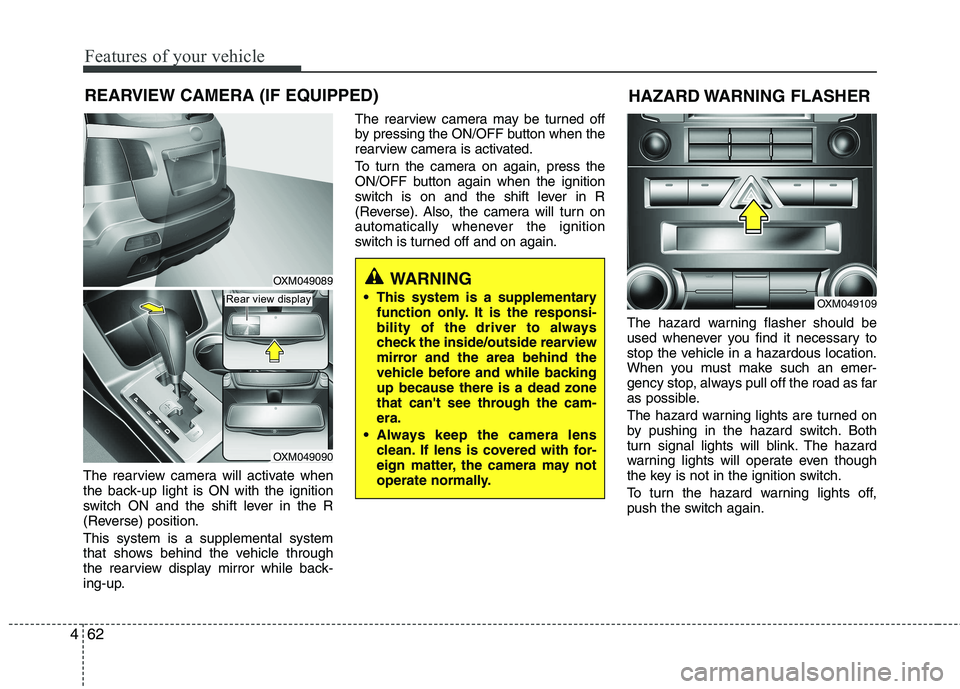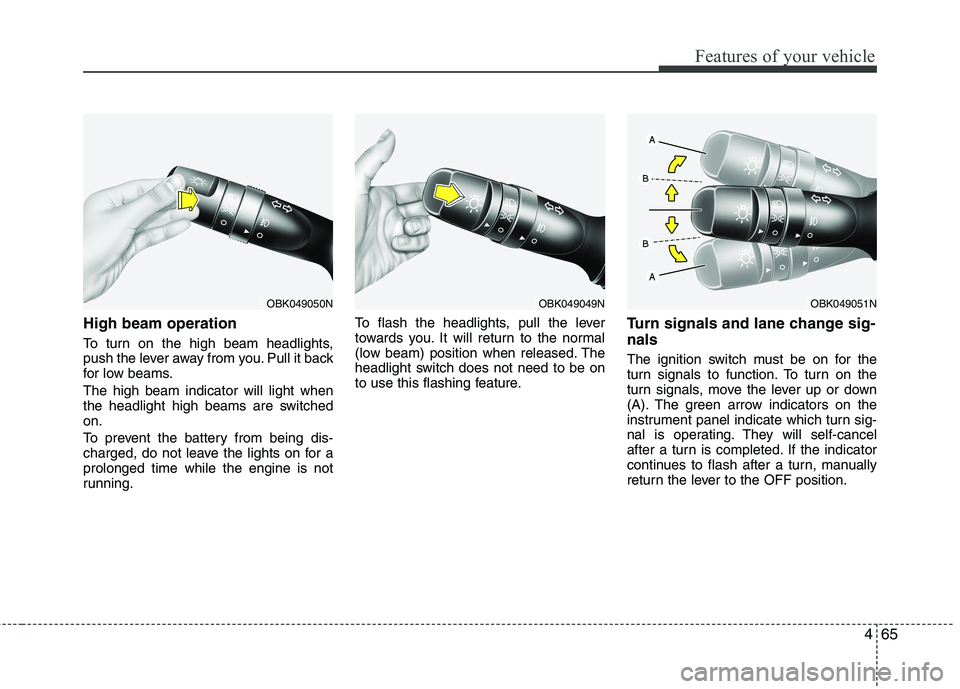2010 KIA SORENTO turn signal
[x] Cancel search: turn signalPage 10 of 399

17
Introduction
INDICATOR SYMBOLS ON THE INSTRUMENT CLUSTER
Seat belt warning light
Door/tailgate open position indicator*
Tailgate open warning light
High beam indicator
Light on indicator*
Turn signal indicator
Front fog light indicator*
ABS warning light
Parking brake & Brake fluid
warning light
Engine oil pressure warning light
4WD system warning light* 4WD LOCK indicator*
Malfunction indicator*
Air bag warning light
Cruise SET indicator*
Low fuel level warning light
Shift pattern indicator*
DBC indicator*
❈ For more detailed explanations, refer to “Instrument cluster” in section 4.
Charging system warning light
Low windshield washer fluid level
warning light*
Door ajar warning light
Overspeed warning light*
120km/h
Key out warning light*KEY
OUT
* if equipped
Glow indicator (Diesel only)
Fuel filter warning light (Diesel only)
Cruise indicator*
Rear fog light indicator*
ESP indicator*
ESP OFF indicator*
Immobilizer indicator*
Low tire pressure telltale*/
TPMS (Tire Pressure MonitoringSystem) malfunction indicator*
Low tire pressure position telltale*
Page 13 of 399

23
Your vehicle at a glance
INSTRUMENT PANEL OVERVIEW
1. Instrument cluster.............................4-39
2. Steering wheel audio controls* ......4-107
3. Light control / Turn signals ...............4-63
4. Horn .................................................4-34
5. Auto cruise controls* ........................5-41
6. Wiper/Washer switch ........................4-69
7. Driver’s front air bag .........................3-47
8. Ignition switch* orENGINE START/STOP button* ...5-4, 5-8
9. Hazard warning flasher .............4-62, 6-2
10. Audio* ...........................................4-107
11. Digital clock ..................................4-102
12. Climate control system* ........4-77, 4-86
13. Power outlet* ................................4-101
14. Cigar lighter* ..................................4-99
15. Shift lever ..............................5-17, 5-14
16. AUX, USB and iPod port*.............4-108
17. Seat warmer switch* ........................3-9
18. Parking brake pedal* ......................5-31
19. Brake pedal ....................................5-30
20. Accelerator pedal .............................5-5
21. Passenger’s front air bag* ..............3-47
22. Glove box .......................................4-97
* : if equipped
OXM019002
Page 56 of 399

Safety features of your vehicle
42
3
How does the air bag system operate
Air bags are activated (able to inflate if
necessary) only when the ignition
switch is turned to the ON or STARTposition.
Air bags inflate instantly in the event of a serious frontal collision or side colli-sion (if equipped with a side air bag or
curtain air bag) in order to help protect
the occupants from serious physical
injury.
✽✽ NOTICE - For Europe
Also, the air bags inflate instantly in the
event of a rollover (if equipped with a
side airbag or curtain air bag) in order
to help protect the occupants from seri-
ous physical injury.
There is no single speed at which the air bags will inflate.
Generally, air bags are designed to
inflate based upon the severity of a col-
lision and its direction. These two fac-
tors determine whether the sensors
produce an electronic deployment/inflation signal. Air bag deployment depends on a num-
ber of factors including vehicle speed, angles of impact and the density and
stiffness of the vehicles or objects which
your vehicle hits in the collision. The
determining factors are not limited to
those mentioned above.
The front air bags will completely inflate and deflate in an instant.
It is virtually impossible for you to see the
air bags inflate during an accident.
It is much more likely that you will simply see the deflated air bags hanging out of
their storage compartments after the col-lision.
In order to help provide protection in a severe collision, the air bags must inflate
rapidly. The speed of the air bag inflation
is a consequence of extremely short timein which a collision occurs and the need
to inflate the air bag between the occu-
pant and the vehicle structures before
the occupant impacts those structures.
This speed of inflation reduces the risk of
serious or life-threatening injuries in a
severe collision and is thus a necessary
part of the air bag design.
However, air bag inflation can also
cause injuries which can include facial
abrasions, bruises and broken bonesbecause the inflation speed also causes
the air bags to expand with a great deal
of force. There are even circumstances
under which contact with the steer-
ing wheel air bag can cause fatal
injuries, especially if the occupant
is positioned excessively close tothe steering wheel.
WARNING
To avoid severe personal injury or death caused by deploying air
bags in a collision, the driver
should sit as far back from the
steering wheel air bag as possi-
ble (at least 250 mm (10 inches)
away). The front passengers
should always move their seats
as far back as possible and sit
back in their seat.
Air bags inflate instantly in the event of a collision, and passen-
gers may be injured by the air bag
expansion force if they are not in
a proper position.
Air bag inflation may cause injuries including facial or bodily
abrasions, injuries from broken
glasses or burns.
Page 114 of 399

439
Features of your vehicle
INSTRUMENT CLUSTER
1. Tachometer
2. Turn signal indicators
3. Speedometer
4. Engine temperature gauge
5. Warning and indicator lights
6. Shift position indicator*
7. Odometer
8. Trip computer*
9. Fuel gauge
10. LCD display*
* : if equippedOXM049050E/OXM049051E
Gasoline Engine■
■ Type A
The actual cluster in the vehicle may differ
from the illustration.
■■
Type B
Page 115 of 399

Features of your vehicle
40
4
1. Tachometer
2. Turn signal indicators
3. Speedometer
4. Engine temperature gauge
5. Warning and indicator lights
6. Shift position indicator*
7. Odometer
8. Trip computer*
9. Fuel gauge
10. LCD display*
* : if equipped
OXM049050C/OXM049051L
Diesel Engine■
■ Type A
The actual cluster in the vehicle may differ
from the illustration.
■■Type B
Page 124 of 399

449
Features of your vehicle
Your vehicle is equipped with dual-diago-
nal braking systems. This means you still
have braking on two wheels even if one
of the dual systems should fail. With only
one of the dual systems working, more
than normal pedal travel and greaterpedal pressure are required to stop the
vehicle. Also, the vehicle will not stop in
as short a distance with only a portion of
the brake system working. If the brakes
fail while you are driving, shift to a lower
gear for additional engine braking and
stop the vehicle as soon as it is safe to do
so.
To check bulb operation, check whether
the parking brake and brake fluid warning
light illuminates when the ignition switchis in the ON position.Seat belt warning andchime (if equipped)
Seat belt warning light
As a reminder to the driver and passen-
ger, the seat belt warning light will blink
or illuminate for approximately 6 seconds
each time you turn the ignition switch ON
regardless of belt fastening.
For details, refer to the seat belt on chap- ter 3.
Turn signal indicator
The blinking green arrows on the instru-
ment panel show the direction indicated
by the turn signals. If the arrow comes on
but does not blink, blinks more rapidly
than normal, or does not illuminate at all,
it indicates a malfunction in the turn sig-
nal system. You should consult your deal-
er for repairs.
This indicator also blinks when the haz-
ard warning switch is turned on.
High beam indicator
This indicator illuminates when the head- lights are on and in the high beam posi-
tion or when the turn signal lever is pulled
into the Flash-to-Pass position.
Light on indicator
(if equipped)
The indicator illuminates when the tail lights or headlights are ON.
WARNING
Driving the vehicle with a warning
light on is dangerous. If the brake
warning light remains on, have the
brakes checked and repaired imme-
diately by an authorized KIA dealer.
Page 137 of 399

Features of your vehicle
62
4
The rearview camera will activate when
the back-up light is ON with the ignition
switch ON and the shift lever in the R
(Reverse) position. This system is a supplemental system
that shows behind the vehicle through
the rearview display mirror while back-
ing-up. The rearview camera may be turned off
by pressing the ON/OFF button when the
rearview camera is activated.
To turn the camera on again, press the
ON/OFF button again when the ignition
switch is on and the shift lever in R
(Reverse). Also, the camera will turn on
automatically whenever the ignition
switch is turned off and on again.
The hazard warning flasher should be
used whenever you find it necessary to
stop the vehicle in a hazardous location.
When you must make such an emer-
gency stop, always pull off the road as far
as possible.
The hazard warning lights are turned on
by pushing in the hazard switch. Both
turn signal lights will blink. The hazard
warning lights will operate even though
the key is not in the ignition switch.
To turn the hazard warning lights off,
push the switch again.
OXM049109
HAZARD WARNING FLASHER
WARNING
This system is a supplementary function only. It is the responsi-
bility of the driver to always
check the inside/outside rearview
mirror and the area behind the
vehicle before and while backingup because there is a dead zone
that can't see through the cam-era.
Always keep the camera lens clean. If lens is covered with for-
eign matter, the camera may not
operate normally.OXM049089
OXM049090
REARVIEW CAMERA (IF EQUIPPED)
Rear view display
Page 140 of 399

465
Features of your vehicle
High beam operation
To turn on the high beam headlights,
push the lever away from you. Pull it back
for low beams. The high beam indicator will light when
the headlight high beams are switchedon.
To prevent the battery from being dis-
charged, do not leave the lights on for aprolonged time while the engine is not
running.To flash the headlights, pull the lever
towards you. It will return to the normal
(low beam) position when released. The
headlight switch does not need to be on
to use this flashing feature.
Turn signals and lane change sig- nals
The ignition switch must be on for the
turn signals to function. To turn on the
turn signals, move the lever up or down
(A). The green arrow indicators on the
instrument panel indicate which turn sig-
nal is operating. They will self-cancel
after a turn is completed. If the indicator
continues to flash after a turn, manually
return the lever to the OFF position.
OBK049050NOBK049049NOBK049051N